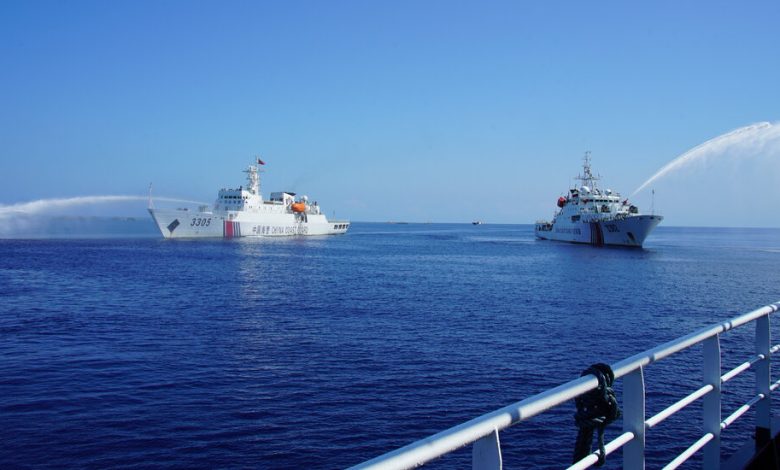What It Feels Like to Be the Target of China’s Water Cannons

The Filipino fishers on wooden boats waved at our vessel, a Philippine fisheries boat, from less than a mile away, but no one on our ship dared to move. Encircling us were two Chinese Coast Guard ships and five Chinese militia vessels.
Then came the water cannon.
One of the Chinese Coast Guard ships had fired the high-intensity water jet at our boat to prevent us from getting closer to fishermen near the Scarborough Shoal, a triangular chain of reefs and rocks 140 miles west of the Philippines. The blast of water rocked the vessel like an earthquake at sea. “Emergency!” Armando Hachuela, the ship’s captain, shouted to the crew and journalists on the deck. “Inside, now!”
A reporter for The New York Timeswas among journalists invited by the Philippines on one of three ships deployed by the country’s fisheries bureau on a mission Saturday to provide fuel to Filipino fishermen.

Filipino fishermen getting fuel from a Philippine government boat near the Scarborough shoal on Saturday.Credit…Camille Elemia for The New York Times
The Scarborough Shoal is a major flashpoint between Manila and Beijing. China claims 90 percent of the South China Sea, including waters hundreds of miles from the Chinese mainland. It took control of Scarborough Shoal in 2012 after a standoff with the Philippines, and has maintained a constant coast guard presence there, restricting entry to the lagoon.
President Ferdinand E. Marcos Jr. of the Philippines has stepped up efforts to resist China’s blockade in these waters. He has also deepened Manila’s partnerships with the United States, Japan, Canada, and even Vietnam, which also claims parts of the disputed waters, to deter China. Many countries have urged Beijing to respect a 2016 ruling by an international court that invalidated China’s wide-ranging claim over the waters. China has ignored that court ruling and continued its expansion in the region, building artificial islands and military outposts.
After multiple maritime clashes with Chinese vessels in recent months, the Philippines started inviting journalists on its resupply missions to Philippine-claimed islands and features in a strategy aimed at showing how China is flexing its military might in the disputed waters.
The ships on Saturday’s mission departed from a port in the western Philippine province of Bataan and arrived near the Scarborough Shoal after 18 hours on rough high seas. Two 100-yard-long Chinese Coast Guard ships were already there. Not long after, several Chinese militia ships joined them. The Chinese ships blocked the Philippine ships from reaching the fishers, eventually colliding with at least one of the vessels in a standoff that lasted more than eight hours.
On a separate resupply mission by the Philippines on Sunday to the Sierra Madre, an old rusty ship that serves as Manila’s outpost in the Second Thomas Shoal, a Chinese Coast Guard vessel fired water cannons at a wooden Philippine resupply ship. The damage to the Philippine boat was so severe that it had to be towed back to port.
Mr. Marcos condemned the “aggressions and provocations” of Chinese ships over the weekend and said their presence violated international law. “No one but the Philippines has a legitimate right or legal basis to operate anywhere” within the country’s exclusive economic zone, Mr. Marcos said.
The Chinese Coast Guard defended its actions against the Philippine ships as “professional, standardized, legitimate, and legal.” In statements released over the weekend and on Monday, China warned the Philippines to “strictly control frontline provocations and not shoot itself in the foot.” The Coast Guard said the Philippine boat on Sunday had “swerved suddenly in an unprofessional and dangerous manner, and deliberately collided” with the Chinese Coast Guard ship.
During the mission on Saturday, the Philippine fisheries vessels moved a few yards away from the shoal after being blocked by the Chinese boats. The Filipino fishermen then rowed toward the government ships using narrow outrigger boats, and lined up to fill their fuel containers.
“It’s painful,” said Dennis Maige, a fisherman who was on one of the small boats. “You see Filipinos being defeated like that in our very own territory.”
China’s Coast Guard vessels then deployed a dinghy to patrol the area. From the bridge of a Chinese militia ship, a man shouted in Mandarin: “Go away,” even as the ship moved closer to the Philippine boats. Another man followed also shouting in Mandarin: “Leave!”
Then, the Chinese boat hit our ship three times, damaging its railings and scraping the right side of the hull.
In total, our ship was hit by water cannon at least five times. The radar and antenna were damaged. Manila later said that China also used a long-range acoustic device that temporarily caused severe discomfort and weakness to some Filipino crew, but there was no evidence of this on the ship we were on.
The confrontation prompted the Filipino officials to cut the trip short.
As the Philippine ships prepared to sail home, China Coast Guard vessels moved close.
LED signs on their sides flashed a message, warning the Philippines: “Do not take inappropriate actions that may affect maritime safety.”
Sui-Lee Wee and Claire Fu contributed reporting.



